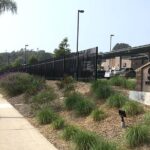ENCINITAS — The state says Encinitas must revise its proposed affordable housing plan by estimating more plausible site development capacities and modifying its process of zoning-by-referendum.
The revisions “are necessary to bring the city’s draft Housing Element into compliance with [state law],” according to an Aug. 27 letter to the city from the state’s Department of Housing and Community Development (HCD).
Cities must regularly update the Housing Element (or chapter) of their General Plans, ostensibly to enable private sector housing production to satisfy forecasted demand, affordably, at all incomes. Encinitas submitted its 2021-2029 update in June for the state’s review.
In its letter, “HCD cautions the city on its approach to estimating realistic capacity on sites identified to accommodate the city’s lower-income [housing target].”
The city’s plan assumes developers would build only lower-income units on 15 parcels. Yet, as The Coast New previously reported, sites with pending development proposals would yield only about one-quarter of their forecasted unit capacities as affordable. At that rate, the city’s plan would generate about half its target.
To make up the deficit, Encinitas would likely need to “up-zone” additional parcels to allow more density — namely, bigger multi-family buildings. The state generally considers 30 units per acre the minimum density necessary to spread costs to finance building lower-income units.
HCD wants Encinitas to modify the process by which future up-zoning would occur so it doesn’t recurrently fail to meet Housing Element deadlines, as in the past.
Council up-zoned sites for its expiring 2013-2021 Housing Element only after a judge compelled the city to comply with state housing law, long past the statutory due date.
The delay stemmed from an impasse between state rules and Proposition A, a 2013 initiative requiring Encinitas voters to approve certain land uses and building heights. Voters blocked Housing Element up-zoning twice, rejecting Measure T in 2016 and Measure U in 2018.
To break the deadlock, the judge let the Council temporarily bypass voters. But he declined to annul Proposition A, citing initiative and referendum powers enshrined in the state constitution.
HCD worries history could repeat itself, saying in its letter the city’s submitted plan “is wholly inadequate to mitigate the effects of Prop A” on timely future compliance.
“The city is currently litigating issues regarding Proposition A,” City Manager Jennifer Campbell said. She expects to respond formally to HCD by month’s end.
Some Encinitas residents believe Proposition A merely checks plans with excessive up-zoning but doesn’t inherently obstruct all up-zoning a Housing Element might require.
“It’s not a cap on growth, it just puts the people in the position of the final approval,” Planning Commissioner Bruce Ehlers said at a Sept. 13 panel.
“I do not believe that Prop A needs any mitigation,” said Susan Turney, District 2 council candidate. “I trust residents to pass a plan that delivers on the promise of affordable housing while adding only the minimum [density] required by law.”
Turney believes voters would approve some, albeit less, up-zoning if a stricter inclusionary housing policy required builders to reserve more of the added density as affordable units. Otherwise, she says up-zoning is mostly just a boon for developers, who profit from extra market-rate units.
Los Gatos requires developers to make up to 40% of new residential projects affordable at lower incomes, whereas Encinitas requires 10-15%.
“HCD has consistently identified Proposition A as an unlawful impediment to compliance with state housing element law,” HCD spokeswoman Alicia Murillo told The Coast News, citing published guidance. “Local inclusionary policies are not an alternative to compliance with state Housing Element law.”
“The only thing that should be done about Prop A is to respect it by honoring the will of the voters,” mayoral candidate Julie Thunder said.
“Poorly conceived plans may be rejected under Prop A, but it isn’t the absolute barrier it is made out to be,” said Alexander Riley, District 1 council candidate. “Yorba Linda and Escondido have similar laws to Prop A [which haven’t] been a hindrance to new development.”
The Building Industry Association of San Diego didn’t respond to a request for comment.




4 comments
“Lauren,” no one on current Council could comment because Prop A is in Court, after the City cooperated with Developers to overturn the public votes for Prop A and Against Measures T and U.
Voters rejected these plans because they were NOT in our best interests. Our road and water, sewer infrastructure cannot support the density. While “Smaller units at higher density are more affordable by design,” they are NOT more affordable, on the Coast, in practice, just as they would not be in NYC, or Los Gatos.
Other cities have found solutions, including Solana Beach, which also had a voter approved proposition, similar to our Prop A in effect. Logically, one CANNOT PROVE A NEGATIVE. You cannot prove that voters would NEVER pass an affordable housing initiative that was reasonable. Projects should be considered on a case by case basis. If we voted by mail, it would NOT be that expensive to vote on reasonable, sustainable projects. The State, through HCD Regional agencies, such as SADAG, has taken away more and more of our local control.
So many agencies are corrupted by money. Development and real estate has been the primary money making engine in Encinitas, from my perspective. We used to be the flower capital of the world; now we’re known for having a “hot” real estate market. It is wrong that Del Mar can qualify with 20 units per acre, and we are forced to have 30 per acre? I don’t understand why the inclusionary housing numbers can’t be raised, here, as they are Los Gatos.
In my opinion, instead of wasting $50 Million plus on a Streetscape on N101 that would rob us of one lane northbound and one lane southbound, for motorists, squeezing all bicyclists and motorists through four narrow, one-lane roundabouts, increasing congestion, increasing traffic cutting through residential neighborhoods and a school zone, increasing the time emergency vehicles take to respond, increasing green house gases, hurting already devastated small businesses, rather than forcing a boondoggle public works project on us WITHOUT allowing a public vote on General Obligation Bonds, our current mayor and council could put that money into subsidizing affordable housing on publicly owned lands. For example, we WOULD VOTE to allow low income artists to live and have art studios at Pacific View, which is zoned for public/semi public use, and for which property we taxpayers are paying, dearly, now.
No acffordable housing has been built in Los Gatos since 2003. Here is one property up for sale, $274,000+
https://www.mercurynews.com/2019/12/21/no-typo-this-1-1-million-los-gatos-house-is-selling-for-274000/
If not for Prop A, the earlier housing element update passed by the City Council in 2016 would have been enacted and fewer parcels would have been up zoned and the city would have saved over a million dollars in legal fees. Smaller units at higher density are more affordable by design. Deed restrictions are not the only way to fill the gap of housing for those just starting out or with limited means. Why were no current Council members interviewed for this story? Only the opponents, who engage in magical thinking, are quoted. There is no evidence to support the idea that if only the inclusionary requirements were higher, the voters would approve an upcoming measure.
Del Mar is having the same problem with only upzoned 20 apartments per acre and should sue HCD for false pretenses.
The residents of Encinitas were told that upzoning “to meet the law” required 30 housing units per acre and 20 units weren’t allowed. The builders told HCD that they needed taller buildings to give occupants more spacious apartments. HCD agreed, the Encinitas council agreed and increased the building height. Builders wanted to count unbuildable areas on property to get more housing allowed. HCD and council agreed. These changes and more were part of the 5th cycle housing element update (HEU).
Fast forward to the draft 6th cycle where results are given on 7 submitted projects of the 5th cycle upzoned properties. Buried in Appendix C part 1 of the 6th cycle draft HEU shows only 227 low income apartments to be built out of the projected 847 low income in the HEU. Another 1,453 market rate apartments for the financial benefit of the developers will be built. One apartment building complex will be 7 stories tall with 283 apartments but only 42 low income apartments instead of the 149 projeccted.
Encinitas Mayor Blakespear and council have repeated to residents that no more upzoning will occur. However, HCD has put the city on notice more upzoning is needed to meet the 5th and 6 cycle HEU low income.
Unfortunately, that upzoning won’t come until after the election where Blakespear, Kranz, and Hinze want to be re elected to continue the upzoning but haven’t revealed all the upzoning in the city that they can approve.
Only a simple council (3 members) vote is needed to increase zoning if Prop A (and residents right to vote) loses in court. In the meantime, HCD will pretend and let the council continue to pretend that the upzoned properties will have the projected low income housing unitrs shown in the 5th cycle HEU. Remember, these “laws” were voted in by state representatives who were elected on the local (our) level. Some of the politicians have moved on to other offices after their damaging votes to local government control.
Encinitas needs new leadership, and the HCD agency should be eliminated.
Comments are closed.